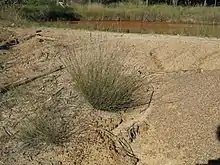| Aristida ramosa | |
|---|---|
 | |
.jpg.webp) | |
| Scientific classification | |
| Kingdom: | Plantae |
| Clade: | Tracheophytes |
| Clade: | Angiosperms |
| Clade: | Monocots |
| Clade: | Commelinids |
| Order: | Poales |
| Family: | Poaceae |
| Genus: | Aristida |
| Species: | A. ramosa |
| Binomial name | |
| Aristida ramosa | |
Aristida ramosa (common name Purple wiregrass) is a species of grass (in the family Poaceae) that occurs in New South Wales, Victoria, Western Australia and Queensland.[1] However, it is thought to have been introduced into Western Australia.[2] It was first described by Robert Brown in 1810 who find it live at Port Jackson (Sydney).[3][4] The species epithet, ramosa, is a Latin adjective meaning "branched" which describes the plant as bearing branches.[5]
Description
A ramosa is a tufted perennial, with smooth internodes, growing from 37 to 120 cm high. The inflorescences are 8 to 27 cm long by 1.5 to 2 cm wide. It grows in Bluegrass downs (Dichanthium spp.), Brigalow, Eremophila, Eucalyptus and Triodia communities in varied soils, and flowers and fruits all year round.[2]
See also
References
- ↑ "PlantNET - FloraOnline: Aristida ramosa". plantnet.rbgsyd.nsw.gov.au. Retrieved 7 August 2021.
- 1 2 null (2020), "Aristida ramosa", Flora of Australia. Australian Biological Resources Study, Department of Agriculture, Water and the Environment: Canberra, retrieved 7 August 2021
- ↑ "Aristida ramosa". Australian Plant Name Index, IBIS database. Centre for Plant Biodiversity Research, Australian Government.
- ↑ Brown, Robert (1810), Prodromus florae Novae Hollandiae et insulae Van-Diemen, exhibens characteres plantarum quas annis 1802–1805, London: R. Taylor et socii, p. 173, doi:10.5962/BHL.TITLE.3678, Wikidata Q7247677
- ↑ "ramosus,-a,-um". www.plantillustrations.org. Retrieved 6 August 2021.